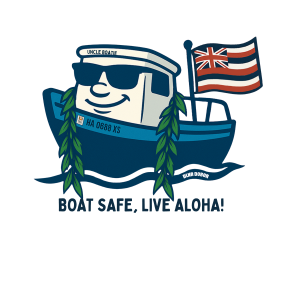Emergency Positioning Indication Radio Beacons

COMMUNICATION
- VHF radios or EPIRBs are required for all recreational vessels traveling more than one mile offshore. Having both is strongly recommended for safety.
- Maintain radio contact when navigating near commercial or naval vessels.
DOBOR RECOMMENDS TRANSITION TO NEW TECHNOLOGY
Older Emergency Positioning Indication Radio Beacons (EPIRBs) operating on the 121.5 MHz and 243 MHz frequencies will be prohibited from use by the U.S. Coast Guard. Commercial boats operating more than three miles off shore will be required to carry 406 MHz digital EPIRBs. In Hawaii, recreational vessels operating more than one mile offshore, unless otherwise equipped with a VHF radio, will be required to carry a USCG approved EPIRB as well. This is a phase out that has been in the works since 1999 when the International Cospas-Sarsat Program announced it would terminate satellite processing of the 121.5 and 243 MHz frequencies emitted by older EPIRBs. The newer 406 MHz system greatly improves the functionality and accuracy of EPIRB units. The Division of Boating and Ocean Recreation (DOBOR) is encouraging all boaters to employ the new technology. COSPAS-SARSAT is an international satellite-based search and rescue system established by the U.S., Russia, Canada and France to locate emergency radio beacons transmitting on the frequencies 121.5, 243 and 406 MHz. The termination date for use of the 121.5 and 243 MHz signals by COSPAS-SARSAT is February 1, 2009. The new 406 MHz system is vastly superior and provides greater accuracy by using GPS in fixing a position in an emergency. Differences between the systems include:
- 5 watts of power in the new EPIRB as compared to 0.1 watt with the old technology
- Global coverage with the new system compared to 2/3 global coverage;
- Beacon ID combined with registration data allows for rapid verification and launch or stand-down. With the old system, alerts are anonymous and no data is transmitted about the beacon owner;
- 1-3 nautical mile accuracy for non GPS units. Better than 300 feet accuracy if GPS equipped. The old system has an accuracy range of 12-15 nautical miles;
- Survivor location limits search to 25 square nautical miles. The old system limits search area to 500 square nautical miles;
- Low false alerts, about 1 in 12. In the old system, fewer than 2 in 1000 alerts are legitimate distress calls.
For boaters that have chosen to equip their boats with radios as opposed to EPIRBs, DOBOR recommends that any boater traveling beyond the reliable range of a VHF radio, about 25 miles, carry a 406 MHz EPIRB onboard their vessel. New users are required to register their beacon for the 406 MHz Beacon Registration Database by phone in the U.S. at 1-800-212-7283 or at: https://beaconregistration.noaa.gov/RGDB/index. The new regulation applies to all Class A, B and S 121.5/243 MHz EPIRBs. It does not apply to 121.5/243 MHz man overboard devices. For more information contact the U.S. Coast Guard Prevention Department, Vessel Inspection at 808-522-8253.
This page was last updated on 09.12.25.
